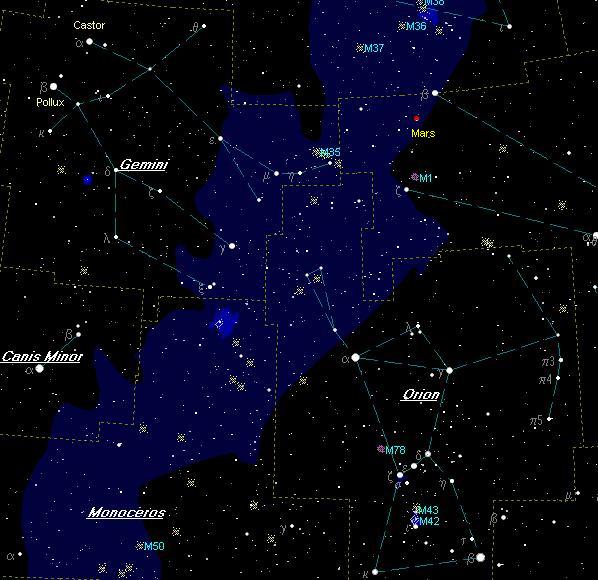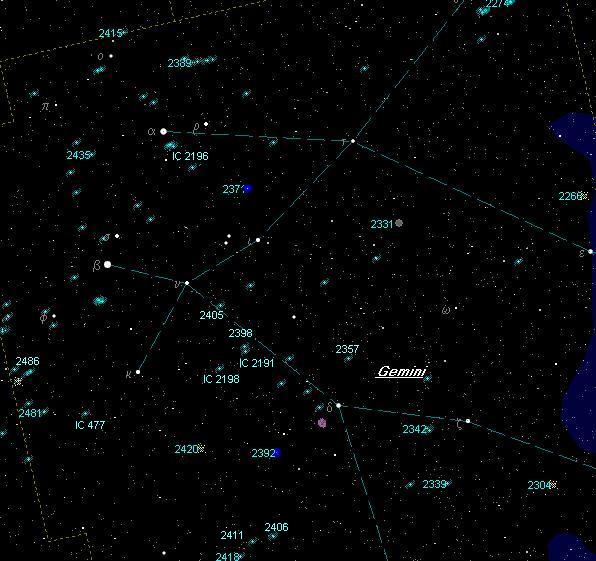The Twins and an Orangey Moon
Ranked as the seventeenth and twenty-third brightest stars, the guideposts to the Twins of Gemini are now located high in the night sky. Their names respectively are Pollux and Castor and shine at magnitudes 1.14 and 1.57. Pollux is a giant orange star that seems to have a hot outer corona like out Sun. It does possess a fainter companion too close to be resolved by an amateur telescope. Although it is brighter than Castor Bayer for some reason gave the designation of alpha (the brightest) to Castor. With a good telescope, three of Castor’s stars can be resolved; however, these are really three double stars giving us a total of six suns that appear as one to the unaided eye.

The true showpiece lying within the Twin’s borders nestled down at the right foot is M35. Taking up the same area as the full Moon, this magnitude 5.3 gem of an open cluster is located close to a much dimmer but dense open cluster – NGC 2158. This tiny bundle of stars measures one-sixth of its neighbour’s area. M35 is an easy target for binoculars and shows up well on wide-angle photography. Its population is listed in the hundreds.
Moving further west we come to IC 2157 and IC 2156 two smaller open clusters. IC 2157 contains a handful of stars and glows at magnitude 8.4. IC 2156 is located 5 degrees north of the brighter and richer IC 2157. Gemini has a number of galaxies including NGC 2339. This face-on structure is listed at magnitude 11.4 and measures a small 3 by 2 arc minutes. A very scattered open cluster is labelled NGC 2331. This loose group lists as magnitude 8.4 and takes up half the area of the full Moon. Be sure to use a low power eyepiece of you might miss it.
For a challenge, move two and a half degrees north of Castor to locate NGC 2389 which is the brightest member at magnitude 12.8 of a chain of galaxies. Other members are NGC 2385, NGC 2379, NGC 2375 and NGC 2373. These tiny islands are in the 13 to 14 magnitude range. Another galaxy group resides within a degree of Theta Geminorum with the brighter two being NGC 2274 and NGC 2275 and are 13th and 14th magnitudes respectively.

One of the best planetary nebulas is the Eskimo Nebula – NGC 2392. The colour is just superb. The true nature of the structure is evident in images taken by the Hubble Space Telescope. You can see that violent solar winds from the central star creating orange coloured striations about a light-year in length. This is a fairly new object as it is estimated to be only 10,000 years old. Astronomers still do not understand the entire nature of this object.
Its time to get the camera gear and telescope ready and prepared to be dazzled. On the night of February 20th, the full Moon called the Snow Moon will slide into Earth’s shadow. The total lunar eclipse starts at 8:43 p.m. eastern ending at 12:09 a.m. This is something the whole family can enjoy. Let’s hope for clear weather for this great event. Comet Holmes is staying pretty close to Algol in the constellation Perseus. It has now ballooned out to 1.5 degrees or three full Moons wide. It is best seen in dark skies and with the Moon out of the way for a couple of weeks, you should spot it with binoculars. It is, however, getting fainter by the week but should last through April.
The red planet Mars put on a good show this year and the planet behaved – no dust storms to block its surface detail. Our distance is increasing and the orangey star is shrinking and getting a bit fainter. The Moon and Mars separated by about a degree will set together on February 16th. Saturn is the next solar system marvel to rise at a decent hour. It is now in Leo, some seven degrees east of Regulus. If you have a hard time finding it, Saturn will be about the Moon on the 21st of the month. In the telescope, you will notice from last year’s show, the rings are tilting inwards. This will continue till the September 2009 edge-on display. Saturn takes a little more than 29 years to circle the Sun. As it does, we see one side of the rings for 13 years than the other side the remaining 16 years. The last edge-on show was in 1995 when I witnessed the rings vanish as they only measure a kilometre wide.
| Object | Type | Magnitude | R.A. | Dec. |
|---|---|---|---|---|
| IC 2191 | Galaxy | 14.8 | 07h 30m 18.0s | +24° 18' 00" |
| IC 2196 | Galaxy | 14.1 | 07h 34m 6.0s | +31° 24' 00" |
| IC 2198 | Galaxy | 15.1 | 07h 34m 6.0s | +23° 58' 00" |
| IC 477 | Galaxy | 15.0 | 07h 52m 5.9s | +23° 28' 00" |
| NGC 2266 | Dense open cluster |
10.0 | 06h 43m 12.0s | +26° 58' 00" |
| NGC 2274 | Round galaxy | 13.0 | 06h 47m 12.0s | +33° 34' 00" |
| NGC 2304 | Dense open cluster |
10.0 | 06h 55m 0.0s | +18° 01' 00" |
| NGC 2331 | Scattered open cluster |
9.0 | 07h 07m 12.0s | +27° 21' 00" |
| NGC 2339 | Round galaxy | 11.4 | 07h 08m 18.0s | +18° 47' 00" |
| NGC 2342 | Round galaxy | 13.2 | 07h 09m 24.0s | +20° 38' 00" |
| NGC 2371 | Planetary nebula | 13.9 | 07h 25m 36.0s | +29° 29' 00" |
| NGC 2389 | Round galaxy | 12.8 | 07h 29m 6.0s | +33° 51' 00" |
| NGC 2392 | Planetary nebula | 10.0 | 07h 29m 12.0s | +20° 55' 00" |
| NGC 2398 | Round galaxy | 15.1 | 07h 30m 18.0s | +24° 29' 00" |
| NGC 2405 | Round galaxy | 14.2 | 07h 32m 12.0s | +25° 55' 00" |
| NGC 2411 | Round galaxy | 14.1 | 07h 34m 35.9s | +18° 17' 00" |
| NGC 2415 | Round galaxy | 12.4 | 07h 36m 54.0s | +35° 15' 00" |
| NGC 2420 | Rich open cluster |
8.3 | 07h 38m 30.0s | +21° 34' 00" |
| NGC 2435 | Elongated galaxy | 13.0 | 07h 44m 12.0s | +31° 38' 00" |
| NGC 2481 | Elongated galaxy | 13.1 | 07h 57m 18.0s | +23° 46' 00" |
| NGC 2486 | Elongated galaxy | 14.0 | 07h 57m 54.0s | +25° 09' 00" |
Venus is slowly sinking in the eastern skies as it rounds the Sun. The two brightest planets of the solar system will be a half degree apart on the morning of February 1, low in the southeast. Try photographing it using trees etc in the foreground.
There are no meteor showers scheduled for February but that does not mean you will see a piece of space junk light up the atmosphere when you least expect it. And finally, if all goes well, the space shuttle Atlantis (STS-122) will lift off the launch pad on February 7th at 2:45 p.m. You can follow the preflight checks, launch, and briefings on NASA TV.
Until next month, clear skies everyone.
Gary Boyle
